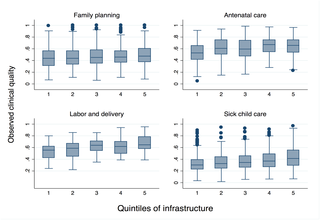PLOS Medicine ( IF 10.5 ) Pub Date : 2017-12-12 , DOI: 10.1371/journal.pmed.1002464 Hannah H Leslie 1 , Zeye Sun 1 , Margaret E Kruk 1

|
Background
It is increasingly apparent that access to healthcare without adequate quality of care is insufficient to improve population health outcomes. We assess whether the most commonly measured attribute of health facilities in low- and middle-income countries (LMICs)—the structural inputs to care—predicts the clinical quality of care provided to patients.
Methods and findings
Service Provision Assessments are nationally representative health facility surveys conducted by the Demographic and Health Survey Program with support from the US Agency for International Development. These surveys assess health system capacity in LMICs. We drew data from assessments conducted in 8 countries between 2007 and 2015: Haiti, Kenya, Malawi, Namibia, Rwanda, Senegal, Tanzania, and Uganda. The surveys included an audit of facility infrastructure and direct observation of family planning, antenatal care (ANC), sick-child care, and (in 2 countries) labor and delivery. To measure structural inputs, we constructed indices that measured World Health Organization-recommended amenities, equipment, and medications in each service. For clinical quality, we used data from direct observations of care to calculate providers’ adherence to evidence-based care guidelines. We assessed the correlation between these metrics and used spline models to test for the presence of a minimum input threshold associated with good clinical quality. Inclusion criteria were met by 32,531 observations of care in 4,354 facilities. Facilities demonstrated moderate levels of infrastructure, ranging from 0.63 of 1 in sick-child care to 0.75 of 1 for family planning on average. Adherence to evidence-based guidelines was low, with an average of 37% adherence in sick-child care, 46% in family planning, 60% in labor and delivery, and 61% in ANC. Correlation between infrastructure and evidence-based care was low (median 0.20, range from −0.03 for family planning in Senegal to 0.40 for ANC in Tanzania). Facilities with similar infrastructure scores delivered care of widely varying quality in each service. We did not detect a minimum level of infrastructure that was reliably associated with higher quality of care delivered in any service. These findings rely on cross-sectional data, preventing assessment of relationships between structural inputs and clinical quality over time; measurement error may attenuate the estimated associations.
Conclusion
Inputs to care are poorly correlated with provision of evidence-based care in these 4 clinical services. Healthcare workers in well-equipped facilities often provided poor care and vice versa. While it is important to have strong infrastructure, it should not be used as a measure of quality. Insight into health system quality requires measurement of processes and outcomes of care.
中文翻译:

基础设施与 4 种医疗保健服务中观察到的护理质量之间的关联:对 8 个国家 4,300 家机构的横断面研究
背景
越来越明显的是,如果没有足够的护理质量,获得医疗保健不足以改善人口健康结果。我们评估低收入和中等收入国家 (LMIC) 卫生设施最常衡量的属性(护理的结构性投入)是否可以预测为患者提供的护理的临床质量。
方法和结果
服务提供评估是由人口与健康调查计划在美国国际开发署的支持下进行的具有全国代表性的医疗机构调查。这些调查评估了中低收入国家卫生系统的能力。我们从 2007 年至 2015 年间在 8 个国家进行的评估中提取了数据:海地、肯尼亚、马拉维、纳米比亚、卢旺达、塞内加尔、坦桑尼亚和乌干达。这些调查包括对设施基础设施的审计以及对计划生育、产前护理 (ANC)、病童护理以及(在两个国家)分娩的直接观察。为了衡量结构性投入,我们构建了衡量世界卫生组织推荐的每项服务的便利设施、设备和药物的指数。对于临床质量,我们使用直接观察护理的数据来计算提供者对循证护理指南的遵守情况。我们评估了这些指标之间的相关性,并使用样条模型来测试是否存在与良好临床质量相关的最小输入阈值。 4,354 个机构的 32,531 项护理观察结果符合纳入标准。设施的基础设施水平中等,平均从患病儿童护理的 0.63 / 1 到计划生育的 0.75 / 1 不等。对循证指南的遵守率较低,在患病儿童护理方面的平均遵守率为 37%,在计划生育方面的遵守率为 46%,在临产和分娩方面的遵守率为 60%,在 ANC 方面的遵守率为 61%。基础设施和循证护理之间的相关性较低(中位数为 0.20,范围从塞内加尔计划生育的 -0.03 到坦桑尼亚 ANC 的 0.40)。基础设施得分相似的设施所提供的护理服务质量差异很大。 我们没有发现与任何服务中提供的更高质量的护理可靠相关的最低水平的基础设施。这些发现依赖于横截面数据,无法随着时间的推移评估结构输入和临床质量之间的关系;测量误差可能会削弱估计的关联。
结论
在这 4 项临床服务中,护理投入与提供循证护理的相关性较差。设备齐全的医疗机构中的医护人员往往提供的护理质量很差,反之亦然。虽然拥有强大的基础设施很重要,但不应将其用作质量衡量标准。洞察卫生系统质量需要衡量护理过程和结果。











































 京公网安备 11010802027423号
京公网安备 11010802027423号